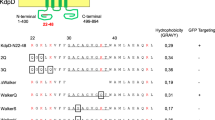Abstract
THE mechanism of protein translocation across the endoplasmic reticulum membrane of eukaryotic cells and the plasma membrane of prokaryotic cells are thought to be evolutionarily related1–7. Protein targeting to the eukaryotic translocation apparatus is mediated by the signal recognition particle (SRP), a cytosolic ribonucleoprotein, and the SRP receptor, an endoplasmic reticulum membrane protein8,9. During targeting, the 54K SRP subunit (Mr 54,000; SRP54), a GTP-binding protein10–12, binds to signal sequences13,14 and then interacts with the α-subunit of the SRP receptor (SRα), another GTP-binding protein12,15. Two proteins from Escherichia coli, Ffh and FtsY, structurally resemble SRP54 and SRα10,11,16. Like SRP54, Ffh is a subunit of a cytosolic ribonucleoprotein that also contains the E. coli 4.5S RNA17,18. Although there is genetic and biochemical evidence that the E. coli Ffh/4.5S ribonucleoprotein has an SRP-like function19–21, there is no evidence for an SRα-like role for FtsY. Here we show that the Ffh/4.5S ribonucleoprotein binds tightly to FtsY in a GTP-dependent manner. This interaction results in the stimulation of GTP hydrolysis which can be inhibited by synthetic signal peptides. These properties mimic those of mammalian SRP and its receptor, suggesting that the E. coli Ffh/4.5S ribonucleoprotein and FtsY have functions in protein targeting that are similar to those of their mammalian counterparts.
Similar content being viewed by others
References
Blobel, G. Proc. natn. Acad. Sci. U.S.A. 77, 1496–1500 (1980).
Briggs, M. S. & Gierasch, L. M. Adv. Prot. Chem. 38, 109–180 (1986).
Müller, M., Ibrahimi, I., Chang, C. N., Walter, P. & Blobel, G. J. biol. Chem. 257, 11860–11863 (1982).
Smith, R. A., Duncan, M. J. & Moir, D. T. Science 1219–1224 (1985).
Roggenkamp, R., Kustermann-Kuhn, B. & Hollenberg, C. P. Proc. natn. Acad. Sci. U.S.A. 78, 4466–4470 (1981).
Görlich, D., Prehn, S., Hartmann, E., Kalies, K.-U. & Rapoport, T. A. Cell 71, 489–503 (1992).
Hartmann, E. et al. Nature 367, 654–657 (1994).
Nunnari, J. & Walter, P. Curr. Opin. Cell Biol. 4, 573–580 (1992).
Rapoport, T. A. Science 258, 931–936 (1992).
Bernstein, H. D. et al. Nature 340, 482–486 (1989).
Römisch, K. et al. Nature 340, 478–482 (1989).
Miller, J. D., Wilhelm, H., Gierasch, L., Gilmore, R. & Walter, P. Nature 336, 351–354 (1993).
Kurzchalia, T. V. et al. Nature 320, 634–636 (1986).
Krieg, U. C., Walter, P. & Johnson, A. E. Proc. natn. Acad. Sci. U.S.A. 83, 8604–8608 (1986).
Connolly, T. & Gilmore, R. Cell 57, 599–610 (1989).
Ogg, S., Poritz, M. & Walter, P. Molec. Biol. Cell 3, 895–911 (1992).
Poritz, M. A. et al. Science 250, 111–117 (1990).
Ribes, V., Römisch, K., Giner, A., Dobberstein, B. & Tollervey, D. Cell 63, 591–600 (1990).
Phillips, G. J. & Silhavy, T. J. Nature 359, 744–746 (1992).
Luirink, J. et al. Nature 359, 741–743 (1992).
Bernstein, H. D., Zopf, D., Freymann, D. M. & Walter, P. Proc. natn. Acad. Sci. U.S.A. 90, 5229–5233 (1993).
Sammuelsson, T. & Olsson, M. Nucleic Acids Res. 21, 847–853 (1993).
Emr, S. & Silhavy, T. J. Proc. natn. Acad. Sci. U.S.A. 80, 4599–4603 (1983).
McKnight, C. J., Briggs, M. S. & Gierasch, L. M. J. biol. Chem. 264, 17293–17297 (1989).
Chen, L., Tai, P. C. Briggs, M. S. & Gierasch, L. M. J. biol. Chem. 262, 1427–1429 (1987).
Connolly, T., Rapiejko, P. J. & Gilmore, R. Science 252, 1171–1173 (1991).
Smith, D. B. & Johnson, K. S. Gene 67, 31–40 (1988).
Author information
Authors and Affiliations
Rights and permissions
About this article
Cite this article
Miller, J., Bernstein, H. & Walter, P. Interaction of E. coli Ffh/4.5S ribonucleoprotein and FtsY mimics that of mammalian signal recognition particle and its receptor. Nature 367, 657–659 (1994). https://doi.org/10.1038/367657a0
Received:
Accepted:
Issue Date:
DOI: https://doi.org/10.1038/367657a0
- Springer Nature Limited
This article is cited by
-
Biochemical analysis of GTPase FlhF which controls the number and position of flagellar formation in marine Vibrio
Scientific Reports (2018)
-
The Archaeal Signal Recognition Particle: Present Understanding and Future Perspective
Current Microbiology (2017)
-
Conformational change of Escherichia coli signal recognition particle Ffh is affected by the functionality of signal peptides of ribose-binding protein
Molecules and Cells (2009)
-
Signal sequence–independent membrane targeting of ribosomes containing short nascent peptides within the exit tunnel
Nature Structural & Molecular Biology (2008)
-
SRP RNA controls a conformational switch regulating the SRP–SRP receptor interaction
Nature Structural & Molecular Biology (2008)





